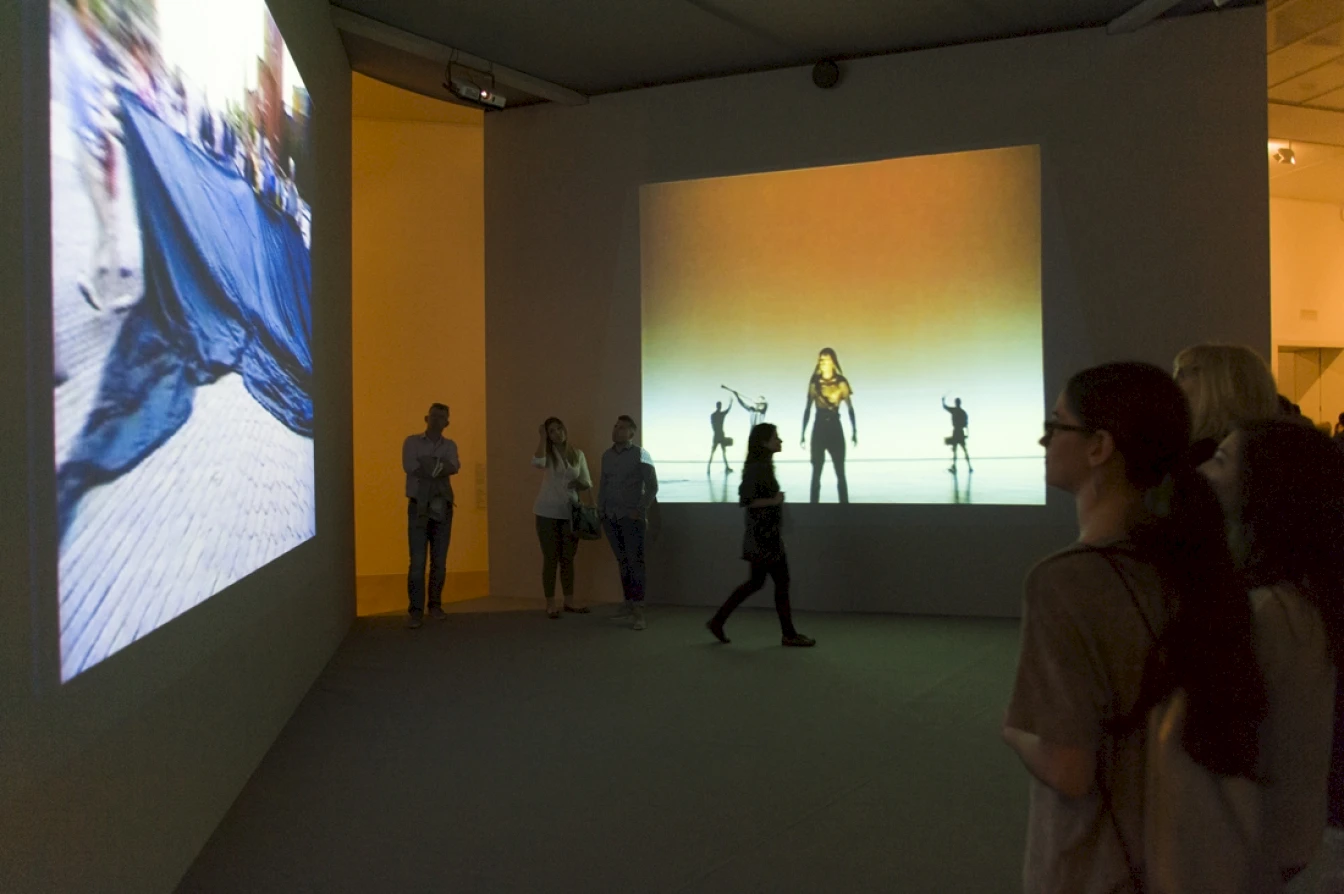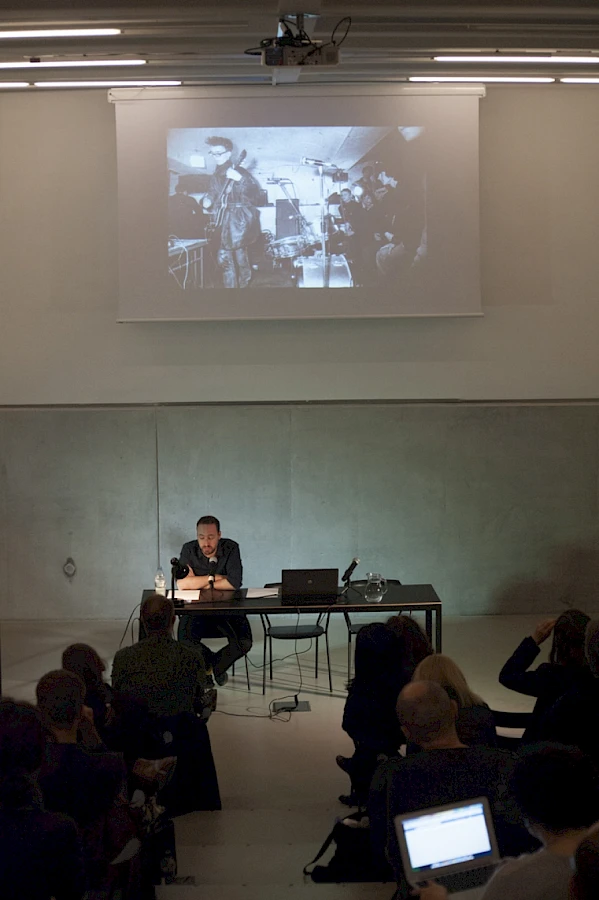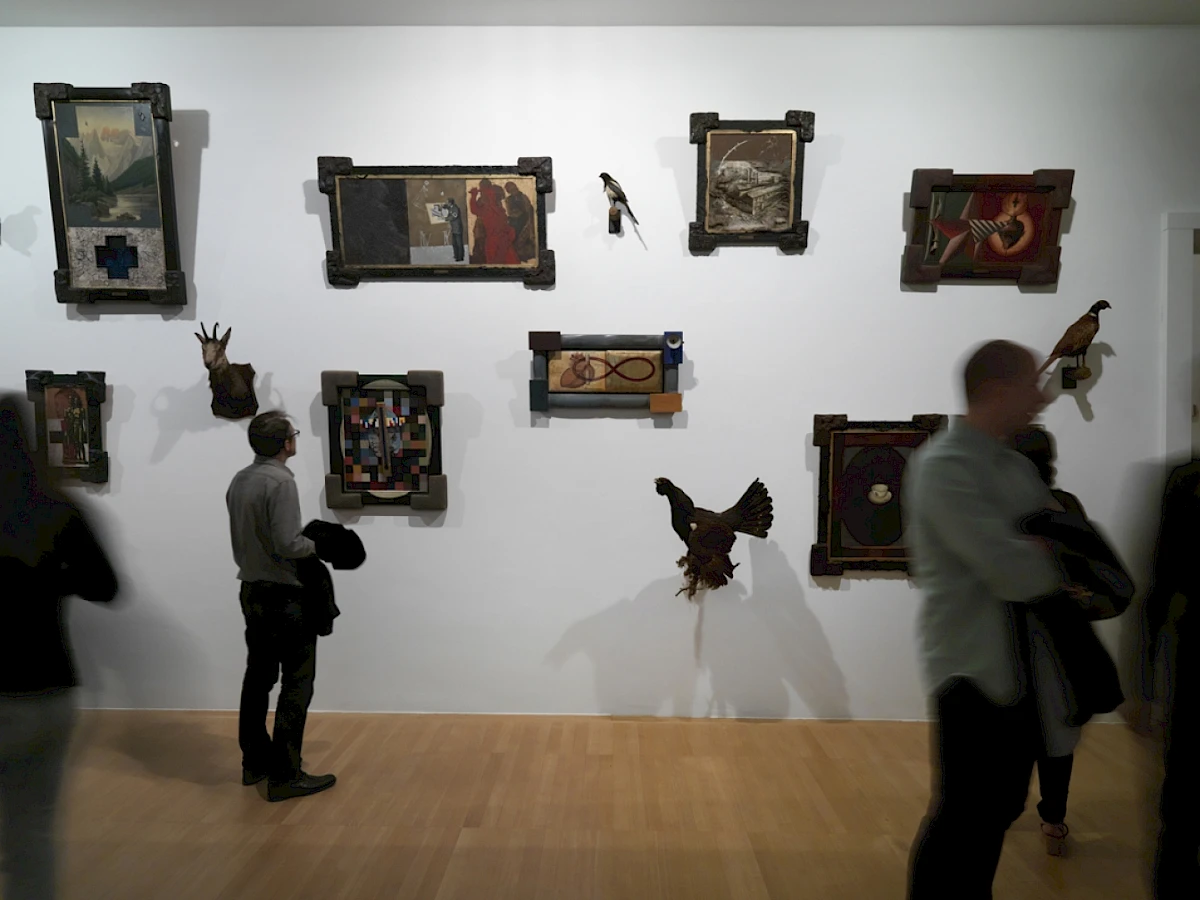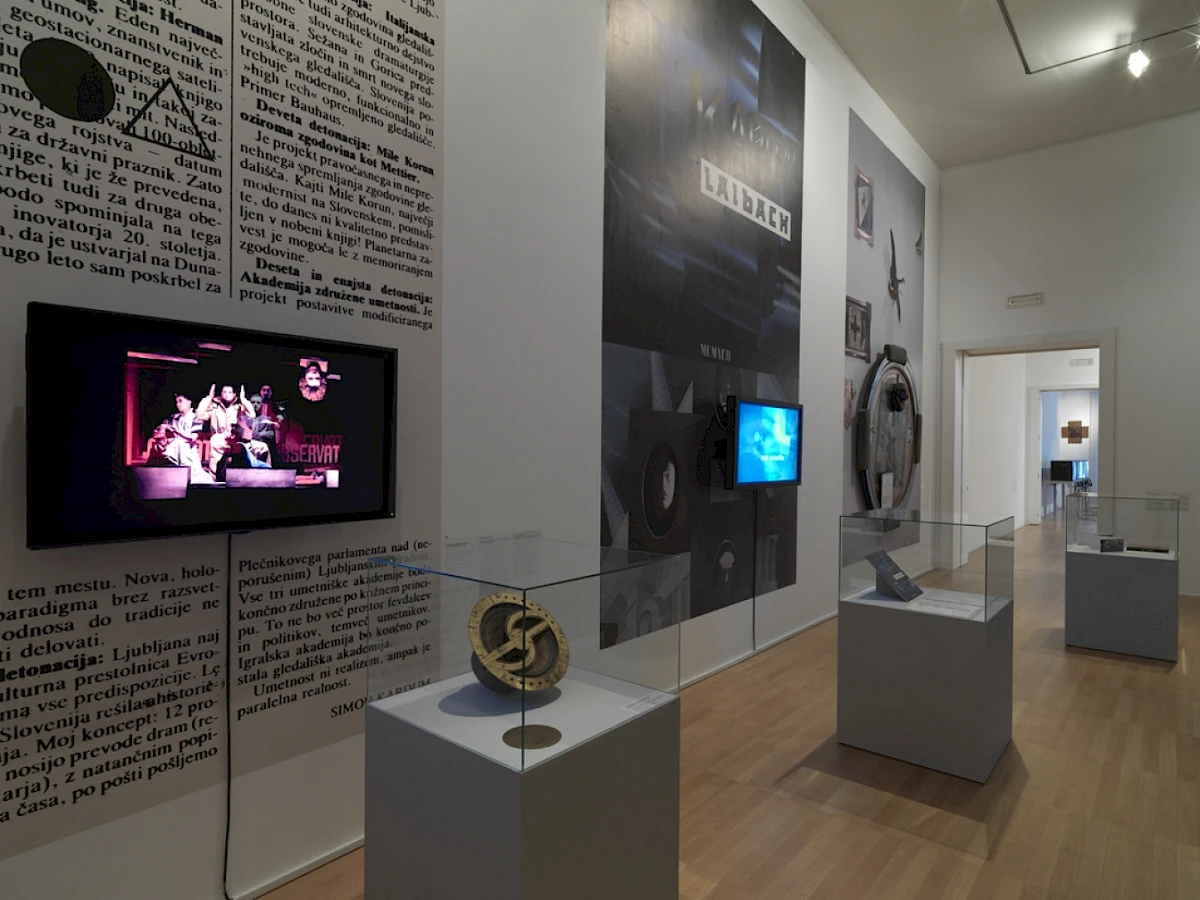Aesthetics of the State? A report on the conference NSK from Kapital to Capital at Moderna galerija, Ljubljana

Installation view of the NSK common room, 'NSK from Kapital to Capital', Moderna galerija, Ljubljana, 2015. Photo: Matija Pavlovec. Courtesy Moderna galerija, Ljubljana.
In June 2015, Moderna galerija hosted a conference to coincide with NSK: from Kapital to Capital. This exhibition, an exhaustive project undertaken by Zdenka Badovinac, was an unprecedented coming together of the practices of the Neue Slowenische Kunst (NSK)'s members: the multi-media group Laibach, the artists IRWIN, Scipion Nasice Sisters Theatre, the design department New Collectivism, the Department of Pure and Applied Philosophy, Retrovision, Film, and Builders.

Anthony Gardner at the international conference 'NSK from Kapital to Capital', Moderna galerija, Ljubljana, 21 June 2015. Photo: Dejan Habicht. Courtesy Moderna galerija, Ljubljana.
In Slovenia and Eastern Europe, NSK has come to be identified, or over-identified to use Slavoj Žižek's term to describe how NSK positioned itself in relation to state ideology, with the 1980s and the break up of Yugoslavia. Specifically the work, reception and subsequent historicisation of NSK should be considered in the context of the proliferation of alternative culture in former Yugoslavia, the emergence of the concept of civil society and its complex relation to the state. Similarly, it is a tangled, contradictory embodiment of ideology in flux, both within Eastern Europe and subsequently the world.
As is the case in any significant cultural moment, NSK can be viewed as both historically and geo-politically specific, emerging out of the conjuncture of "the last decade of Yugoslavia", to quote the sub-heading of the exhibition, and as a way to think through broader questions surrounding culture's relation to ideology, power and institutions. Within NSK, these concepts are simultaneously harnessed and laid bare, deployed and exposed, as both motifs and methodology. This strategy was a means to re-imagine or re-consider the state, put forward most emphatically in NSK's initiation of the State in Time (1991) project, which also served as the chronological endpoint for the exhibition. At a time when our own – and here I speak as a European – relation to hegemonic ideologies and organisations desperately needs to be put under pressure in more expansive ways, understanding what role culture has or can play in re-imagining the state feels prescient. I would like to focus this brief reflection on the negotiation between historical specificity and the wider relation between art, civil society and the state.
Boris Groys' keynote lecture opened the conference by placing the work of Irwin in the context of post-modernism with its privileging of reproduction and remixing. For Groys, Irwin's deployment of existing motifs and signs, pregnant as they were with ideological charge, did not have the perceived luxury of the West's free-floating signifiers. He placed the work of NSK at odds with Western art historical narratives. Indeed, as the modernist canon was never formalised in Eastern Europe and subsequently lacked its normative power, Irwin drew on different forms of state ideology which were politically and culturally loaded in a way that postmodernist cut-and-paste could never be.1
After a general reflection on the genealogy of socialism, in its different national and international mutations, Groys made an interesting move to reposition the relevance of NSK's strategies for today's world. Viewing the notion of the "end of history" (and its subsequent disintegration of ideological binaries) as a new form of globalised, homogenous state, Groys proffered the idea that the contemporary art world endeavours to set up a "non-existent, homogenous, universalist state".

Installation view of theatre groups room, 'NSK from Kapital to Capital', Moderna galerija, Ljubljana, 2015. Photo: Matija Pavlovec. Courtesy Moderna galerija, Ljubljana.
Identifying the huge, un-appointed bureaucracy and systems of power in the art world, he argued that this construct is an attempt to create an image of a universal subject in the absence of the state. NSK's ideologically astute appropriation – as opposed to post-modernism's empty, floating signifiers – tried to thematise or address this nature of contemporary art. Groys suggested that, in this light, NSK and the contemporary left (if there is such a thing) appear as propagandists for an un-specified, imagined state, which was epitomised in the internationalist proposition of their State in Time project.
Groys successfully muddied the water between artistic production, civil society and the state. This thread was taken up, albeit differently, by the Slovene theorist Mladen Dolar on the third day of the conference. He turned to Plato's Republic, in which the ideal state famously has no place for art. Speculating on what could be deemed dangerous about the act of imitation, Dolar stated that no imitation is mere imitation, but that it inherently affects that which it imitates. Drawing tentative comparisons between Plato's notion of mimesis and Žižek's term "over-identification", Dolar put forward the argument that NSK's staging of different state rituals and motifs was akin to Plato's concept of the ideal state, existing as they do in time but not in space. Similarly, by imitating the state, NSK, by inference, affected it. As such, NSK's 'state of the art' becomes the Gesamtkunstwerk par excellence.
Yet Dolar's closing remarks had the biggest impact on the conference since he suggested that the fundamental flaw of the left has been not to ever have a real, pragmatic and workable concept of the state. Dolar argued that Lenin had demanded the dismantling of the state. He then pursued, echoing Groys' remarks, that the current left are in thrall to an abstracted, but never fully theorised concept of what the state could be.
Such a claim is indeed worth considering in the context of NSK and the mutations the Yugoslav state was going through. NSK's relation to the different counter-cultural scenes in Slovenia has been well documented, and was presented at the conference by Barbara Borčić in her extensive, though distinctively self-historicising talk on the history of Gallery Škuc in Ljubljana through the 1980s, as well as by the brilliantly anarchic Igor Vidmar. What perhaps was not given enough focus in the conference due to time constraints was its relation to the emergent notion of civil society in Yugoslavia in the 80s.
In an insightful text titled "Civil Society and Fascism",2 Tomaž Mastnak (who also spoke at the conference) examines the complex relation NSK has with civil society and the state, arguing that NSK's alignment with the push towards civil society, which he describes as being a "postulate, an ideal, an imperative", and subsequently against the state, was merely tactical. Mastnak's text delves into the emancipatory capacities of civil society and the contradictions inherent in civil-social struggles. He writes: "civil society cannot take over and assume state power [...] at the very moment it comes to occupy state power, civil society ceases to be".3 Whereas Antonio Gramsci successfully put forward the idea that civil society was the site for alternative hegemonies to be formulated and contested (contra the state), Mastnak's text outlines what happens when those formulations are acted upon. In this configuration, NSK (and perhaps other forms of cultural practice) appear to slip between and across the self-defeating binary of civil society and state.
In a similar vein, Alexei Monroe gave a fascinating lecture comparing state architecture in communist Yugoslavia and the image of the state it put forward, with that projected by NSK and specifically Laibach. Both were deliberately un-thinkable, Monroe claimed, un-realisable in their aesthetic and ideological claims. Showing images of the extraordinary 1966 Avala TV tower outside Belgrade, Monroe demonstrated how the experimental nature of state-sponsored monumentalist communist architecture was heavily at odds with the controlling nature of state communism. Through architecture, the state projected itself further than it was prepared to go. Laibach's own over-identification with such experimental monumentalism arguably embodies the same double bind. At the heart of Monroe's argument was exposing the "paltriness" of the aesthetics of the real state, compared to that of the artistic or aesthetic state.

Installation view of IRWIN room, 'NSK from Kapital to Capital', Moderna galerija, Ljubljana, 2015. Photo: Dejan Habicht. Courtesy Moderna galerija, Ljubljana.
If NSK's relation – or over identification, with the state – provided the richest thread for the conference, there was also a concerted attempt to link NSK's strategies and modes of working to other art practices and art-historical narratives. In a session given over to looking at NSK in a wider international context, the art historian and co-editor of the NSK reader Anthony Gardner assessed the collectives' practice in relation to the (largely Western-conceived) notion of institutional critique. Identifying four areas where institutional critique has emerged (architecture, relations between artists and institutions, the field of representation, and the institutionalising of institutional critique), Gardner began by asserting that synergies could be found between NSK and these areas of operation. Yet, as Gardner explained, the modes of institutional critique as propagated in the West, take a synchronic, black and white approach to critique that is both complicated and undone by NSK. Its use of the retro-avant-garde and ventriloquising of institutions is both diachronic and deliberately grey. Importantly, NSK was not critiquing an existing public sphere, rather it was pro-actively pushing for its emergence.
If Gardner's lecture effectively laid out the dangers of attempting to fold NSK into established canons, Daniel Quiles' presentation tried to link projects by a diverse group of predominantly Latin American artists to the strategy of over-identification, commonly associated with NSK. The list of projects Quiles drew upon (CADA, the Pinochet Boys and Tania Bruguera to name a few) had similarities in that they took place within the context of dictatorial rule and often used motifs or iconography employed by the state.4 Yet, it seems to me that these strategies never went further than appropriation and remained restricted to the site and duration of the project, rather than the much more programmatic, institutionalised forms of over-identification adopted by NSK. Indeed, Quiles' talk made apparent the aesthetic, historical and ideological specificity of NSK.

Installation view of the NSK common room, 'NSK from Kapital to Capital', Moderna galerija, Ljubljana, 2015. Photo: Dejan Habicht. Courtesy Moderna galerija, Ljubljana.
It was at this point in the conference that the historical construct of NSK – or of historical narratives per se – was most fervently addressed. In a stinging attack on the project, institutional modes of historicisation and cultural capture in toto, theorists Marina Gržinić and Jasmina Založnik critiqued the hegemonic form of the exhibition. Their lecture, which simultaneously lamented the lack of historical perspectives in Slovenia, focused for the most part on NSK's State in Time project as a way in to address how globalisation has only diminished borders for the flow of capital. The biopolitical welfare state, they argued, has now transformed into the necropolitical state, a position that the recent refugee crisis in Europe makes all too clear. Gržinić and Založnik's lecture, though at times pointedly hostile in its rhetoric towards the host museum, brought some much-needed edge to the conference. It finally, though all too briefly, was addressing NSK's relevance today through a new generation of thinkers.
As someone who was born in the 80s, thinking how to view this recent history, I had hoped to see a bigger presence of emergent intellectual and cultural positions (on stage as well as in the audience). Whilst it is understandable that a NSK conference in Ljubljana had to include those (predominantly men) who contributed to and theorised its significance, the balance felt tilted in favour of those whose historical analysis and political footing were well rehearsed. Similarly, whilst the conceptual analysis of NSK's use of over-identification and its relation with the state formed the basis for some of the most interesting arguments, I would have welcomed more detailed analyses of specific works. As some of the closing remarks of the conference commented, however, when aesthetics and the state become so intimately intertwined, it is sometimes hard to differentiate between the two.
